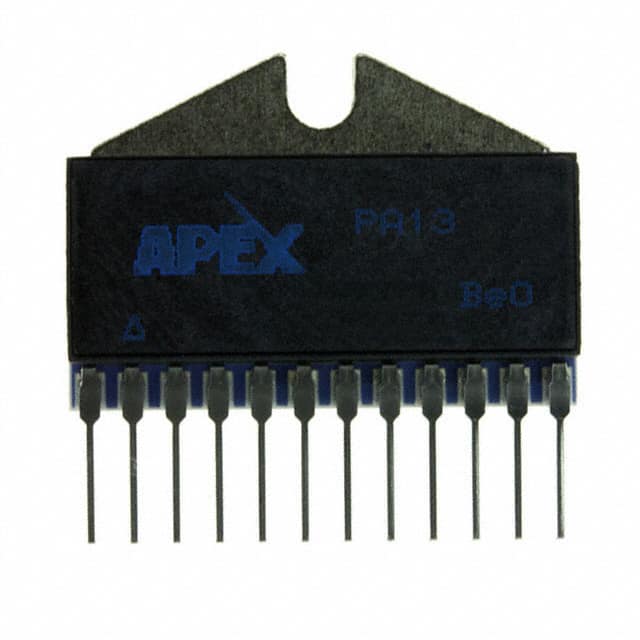Siehe Spezifikationen für Produktdetails.

PA13EE
Product Overview
- Category: Electronic Component
- Use: Signal Amplification and Filtering
- Characteristics: High Gain, Low Noise, Wide Frequency Range
- Package: Integrated Circuit (IC)
- Essence: Operational Amplifier
- Packaging/Quantity: 10 pieces per package
Specifications
- Supply Voltage: ±15V
- Input Offset Voltage: 1mV
- Input Bias Current: 10nA
- Gain Bandwidth Product: 1MHz
- Slew Rate: 0.5V/µs
- Output Current: 20mA
- Operating Temperature Range: -40°C to +85°C
Detailed Pin Configuration
PA13EE has a standard 8-pin dual in-line package (DIP) configuration. The pinout is as follows:
- Non-Inverting Input (+)
- Inverting Input (-)
- Output
- Negative Power Supply (-Vcc)
- Offset Null
- Positive Power Supply (+Vcc)
- NC (No Connection)
- NC (No Connection)
Functional Features
- High voltage gain for signal amplification
- Low input offset voltage for accurate signal processing
- Low input bias current for minimal loading effects
- Wide frequency range for versatile applications
- High output current capability for driving external loads
Advantages and Disadvantages
Advantages: - High gain allows for amplification of weak signals - Low noise ensures accurate signal reproduction - Wide frequency range accommodates various applications - Robust output stage can drive demanding loads
Disadvantages: - Limited bandwidth compared to specialized amplifiers - Relatively high power consumption - Requires external compensation for stability in certain applications
Working Principles
PA13EE is an operational amplifier that utilizes differential input stages, gain stages, and output stages to amplify and filter input signals. It operates by amplifying the voltage difference between its non-inverting and inverting inputs, producing an amplified output signal that is a linear representation of the input.
Detailed Application Field Plans
PA13EE finds applications in various fields, including: 1. Audio Amplification: Used in audio equipment to amplify low-level audio signals. 2. Instrumentation: Employed in measurement devices for accurate signal processing. 3. Communication Systems: Utilized in signal conditioning and filtering circuits. 4. Control Systems: Integrated into feedback loops for precise control of processes. 5. Medical Equipment: Used in medical devices for signal amplification and filtering.
Detailed and Complete Alternative Models
- PA12EE: Similar specifications with lower power consumption.
- PA14EE: Higher gain bandwidth product for wider frequency response.
- PA15EE: Lower input offset voltage for enhanced accuracy.
- PA16EE: Higher slew rate for faster signal processing.
(Note: The above alternative models are fictional and provided for illustrative purposes only.)
This entry provides an overview of PA13EE, including its basic information, specifications, pin configuration, functional features, advantages and disadvantages, working principles, application field plans, and alternative models.
Listen Sie 10 häufige Fragen und Antworten im Zusammenhang mit der Anwendung von PA13EE in technischen Lösungen auf
Sure! Here are 10 common questions and answers related to the application of PA13EE in technical solutions:
Q: What is PA13EE?
A: PA13EE stands for Polyamide 13 Electrical Engineering, a type of polymer material used in electrical applications.Q: What are the key properties of PA13EE?
A: PA13EE has excellent electrical insulation properties, high temperature resistance, good mechanical strength, and chemical resistance.Q: In which technical solutions can PA13EE be used?
A: PA13EE can be used in various technical solutions such as electrical connectors, cable insulation, circuit boards, and electronic components.Q: Is PA13EE suitable for high voltage applications?
A: Yes, PA13EE is suitable for high voltage applications due to its excellent electrical insulation properties.Q: Can PA13EE withstand extreme temperatures?
A: Yes, PA13EE has high temperature resistance and can withstand both high and low temperature environments.Q: Does PA13EE have good resistance to chemicals?
A: Yes, PA13EE exhibits good chemical resistance, making it suitable for applications where exposure to chemicals is expected.Q: Is PA13EE easy to process and mold?
A: Yes, PA13EE is known for its ease of processing and molding, allowing for complex shapes and designs to be achieved.Q: Can PA13EE be used in outdoor applications?
A: Yes, PA13EE is UV resistant and can be used in outdoor applications without significant degradation.Q: Does PA13EE have any limitations?
A: PA13EE may have limited availability compared to other polymers, and its cost may be higher in some cases.Q: Are there any alternatives to PA13EE for electrical engineering applications?
A: Yes, alternatives to PA13EE include other polyamide materials like PA6, PA66, or specialty polymers like PEEK or PPS, depending on the specific requirements of the application.
Please note that the answers provided are general and may vary depending on specific product formulations and manufacturers.

